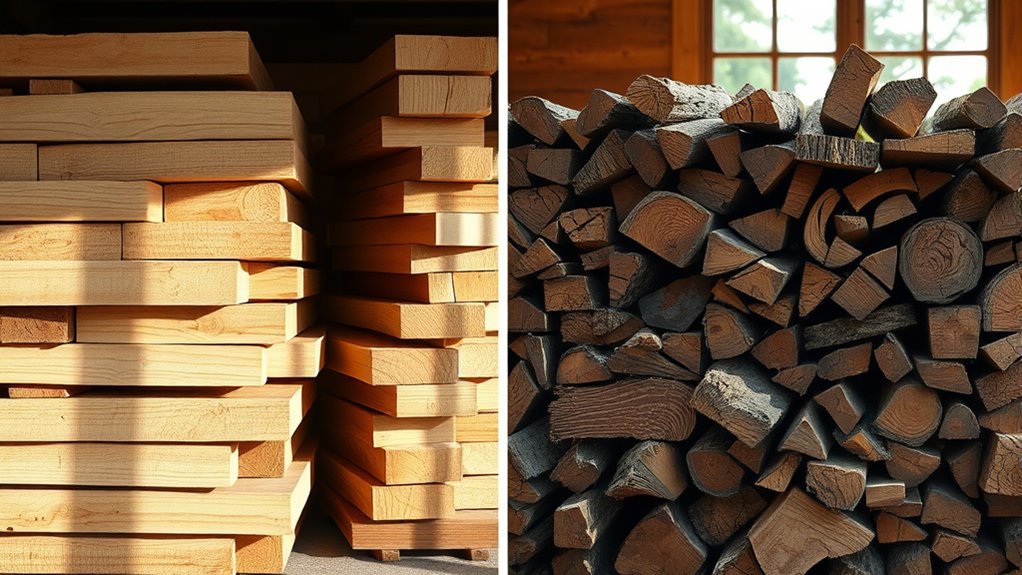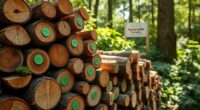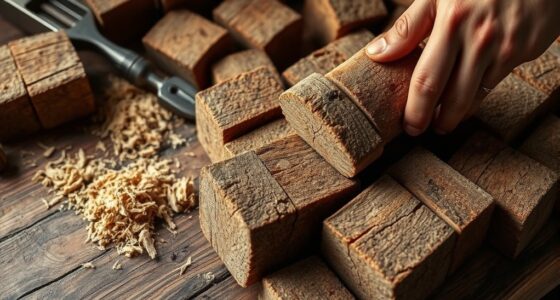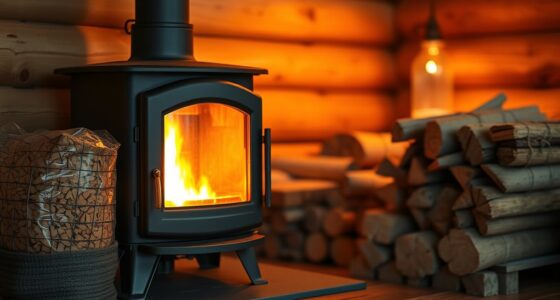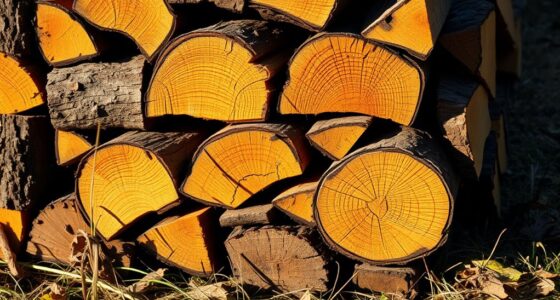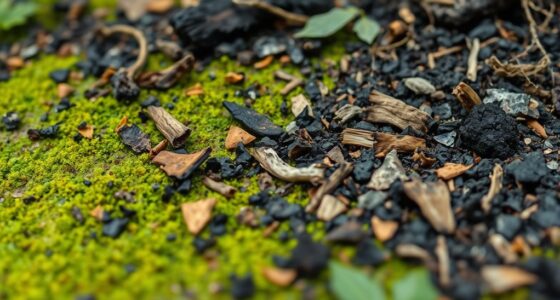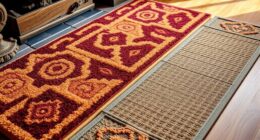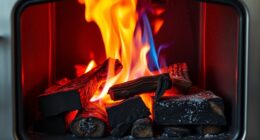When choosing between softwoods and hardwoods for fuel, consider your needs: softwoods, like pine and spruce, ignite quickly and burn hot but produce more smoke and soot, making them ideal for quick heating. Hardwoods, such as oak and maple, burn longer, cleaner, and more steadily with less smoke, but take longer to ignite. To find the best option for your situation and learn more, explore the detailed differences that can help you make a smarter choice.
Key Takeaways
- Softwoods grow faster and are more sustainable, making them ideal for quick heating and eco-friendly choices.
- Hardwoods burn cleaner with less smoke and soot, providing longer, more consistent heat.
- Softwoods ignite quickly and are suitable for rapid fires, while hardwoods offer longer-lasting warmth.
- Softwoods produce more smoke, requiring regular chimney maintenance, unlike cleaner-burning hardwoods.
- The choice depends on whether you prioritize quick heating and sustainability or longer, cleaner burns.
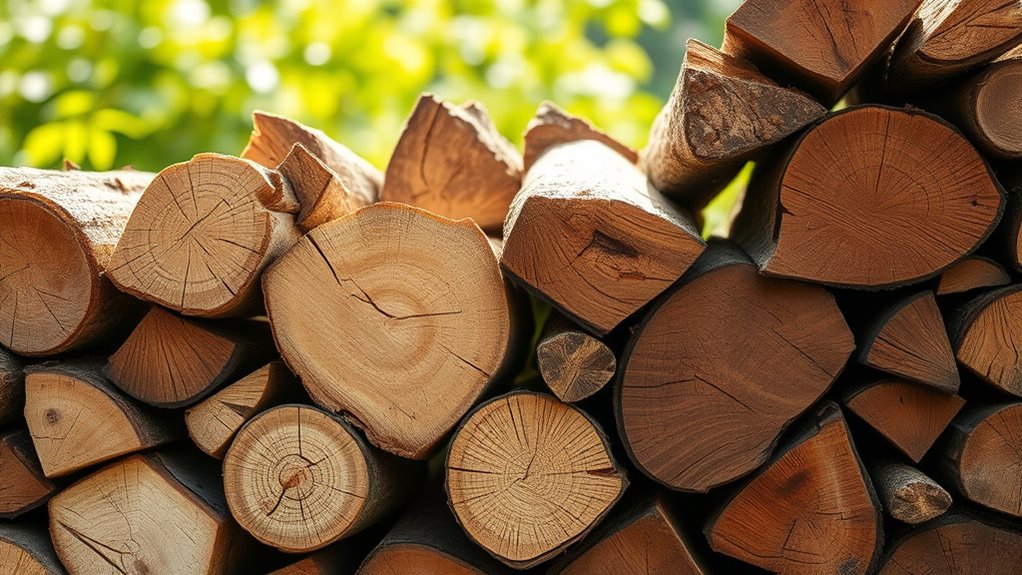
When choosing between softwoods and hardwoods, understanding their fundamental differences is essential. These distinctions impact not only how you use the wood but also the environmental and practical considerations that come with each type. Softwoods, such as pine, cedar, and spruce, generally grow faster and are more readily available, making them a popular choice for many applications. Hardwoods like oak, maple, and cherry, on the other hand, tend to be denser and slower growing, which influences their burning characteristics and sustainability benefits. When considering these factors, it’s important to think about how each type performs as a fuel source, especially regarding smoke production and environmental impact.
Understanding the differences between softwoods and hardwoods helps optimize their use and environmental impact.
Softwoods are often favored for their quick growth and abundance, which translates into better sustainability benefits. Since softwoods regenerate faster, they are considered a more renewable resource, reducing the strain on forests. However, softwoods typically produce more smoke when burned. This increased smoke production can lead to more soot buildup in stoves and chimneys and may contribute to air pollution if not managed properly. If you’re using softwood as fuel, you might notice more emissions and a need for regular cleaning to prevent creosote buildup, which is a safety concern. Despite this, softwoods tend to ignite quickly and burn hotter initially, making them a good choice for quick heating needs, especially if you’re looking for fast, efficient fires.
Hardwoods, by contrast, produce less smoke and tend to burn longer and more steadily, which makes them a preferred option for heating in colder climates. Their lower smoke output means less soot and creosote build-up, reducing maintenance and safety risks. Additionally, the dense nature of hardwoods means they contain more energy per volume, providing more heat over a longer period. While hardwoods may take longer to dry and ignite, their superior burn quality often outweighs this initial inconvenience. When considering sustainability benefits, hardwoods can be a good choice if harvested responsibly, but they are generally less abundant and slower-growing than softwoods, which can influence their environmental footprint. If you prioritize cleaner emissions and longer-lasting fires, hardwoods are typically the better bet.
Ultimately, your choice depends on your specific needs—whether you prioritize quick heat and ease of use with softwoods or longer, cleaner burns with hardwoods. Both types have their advantages and drawbacks, but understanding how they differ in terms of sustainability benefits and smoke production helps you make a more informed decision. Knowing these distinctions allows you to balance environmental concerns with practical performance, ensuring you select the right fuel for your heating or cooking needs.
Frequently Asked Questions
How Does Moisture Content Affect Burning Efficiency?
Higher moisture levels in your wood reduce combustion efficiency, making it harder to burn effectively. When your wood has too much moisture, it absorbs energy to evaporate the water, resulting in incomplete combustion and more smoke. To maximize burning efficiency, you should dry your wood properly, aiming for low moisture content. Properly seasoned wood burns hotter, cleaner, and more efficiently, saving you fuel and reducing emissions.
Are Certain Woods Better for Indoor Vs Outdoor Use?
Think of wood types as musical instruments; some are perfect indoors, others thrive outside. Generally, hardwoods with dense grain patterns like oak or maple are better for indoor use because they burn longer and produce more heat. Softwoods with lighter density and simpler grain patterns, like pine, suit outdoor fire pits or grills. Your choice depends on how long you want the fire to last and the environment’s demands.
What Environmental Impacts Do Different Wood Types Have?
You should consider that different wood types impact the environment differently. Hardwoods often come from slower-growing trees, which can mean a higher carbon footprint if not sourced sustainably. Softwoods, if harvested responsibly through sustainable forestry, tend to have a lower environmental impact. To minimize your carbon footprint, choose woods from certified sources and support sustainable forestry practices, helping preserve forests and reduce ecological harm.
How Do Costs Compare Between Softwoods and Hardwoods?
You’ll find that softwoods generally cost less than hardwoods due to their faster growth and wider availability, making the pricing comparison favorable for softwoods. However, supply availability can vary based on your location and demand, which might influence prices. Softwoods are often more budget-friendly and easier to source, while hardwoods tend to be pricier but offer longer-lasting burns. Consider both costs and supply when choosing your fuel.
Can Mixed Wood Fires Improve Heat Output?
Mixing softwoods and hardwoods can improve heat output because you get the quick ignition of softwoods combined with the longer-lasting burn of hardwoods. To maximize this, guarantee your firewood is properly seasoned and stored seasonally. Proper seasoning reduces moisture, making your mixed wood fire more efficient, providing consistent heat, and reducing smoke. Just remember to balance your wood types for ideal heat and to store your wood correctly before burning.
Conclusion
Just like Robin Hood carefully chooses his arrows, selecting the right wood depends on your needs. Softwoods burn quickly and are great for quick warmth, while hardwoods offer longer-lasting heat, much like a steady, dependable friend. Remember, the choice is yours—each type has its own story to tell, waiting to be written in your fireplace. So, pick wisely and enjoy the cozy fire’s dance, knowing you’re crafting a perfect chapter in your home’s warmth story.

